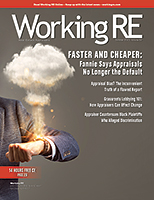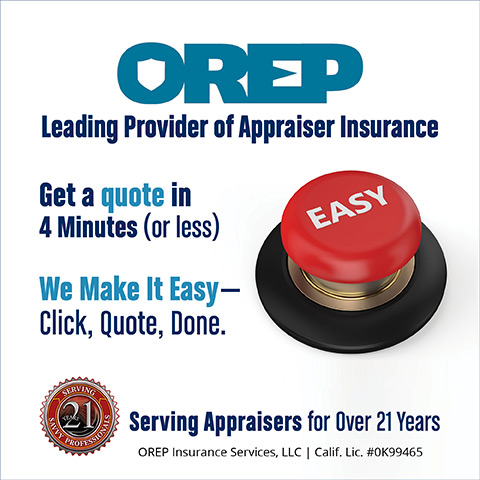 |
> The Appraiser Coach
> OREP E&O |
USPAP and “Protecting the Public Trust”
by Timothy C. Andersen
It is common to hear that appraisers are to protect the public trust. Therefore, by extension, it is also common to hear that protecting the public trust extends to protecting the client—whether that be a lender/GSE, the homeowner, or the borrower. As the basis for this claim, appraisers cite USPAP’s Preamble, which states, “[T]he appraiser’s responsibility is to protect the overall public trust…”. However, for good or bad, the Preamble does not make it clear which public trust we are to protect, nor, in its wisdom, does the USPAP document itself define, explain, or describe what it means by public trust.
But, really, it does, and we’ll get to that in a minute. So, let’s examine the concept some appraisers have that it is our job to protect the lender. Spoiler alert: it’s not our job.
USPAP’s definition of a client is clear, in that there is nothing to persuade anybody that The Appraisal Foundation expects the poor, already-overburdened appraiser to take up the shield of a champion, thus protecting the lender. There is nothing currently in the three components of USPAP’s Ethics Rule that is any more persuasive than the definition of client. A word search in USPAP for the phrase “protect the client” yields zero responses. This same search in the Fannie Mae Selling Guide also resulted in a zero. In USPAP, a word search for “protect” yields 19 hits. Yet none of these is any more persuasive than USPAP’s definition of client; indeed, most of them refer to the Preamble or the definition.
But what about HUD/FHA? John Dingeman, chief appraiser for Class Appraisal and a recognized expert on the HUD/FHA sales guide, said that while the word protect appears sixty times in the HUD/FHA Selling Guide 4000.1, not one of those is in the context of the appraiser protecting the client. Some of those entries are in the context of the appraiser supplying data and information the client can use to protect itself and HUD/FHA, but none of those references casts the appraiser as the lender’s champion.
When we look at USPAP’s definition of an appraiser, there is nothing there to suggest the appraiser protects the client (or anybody else, for that matter). Indeed, that definition requires the appraiser to be competent, independent, impartial, and objective in providing a value conclusion. A champion, one whose charge is to protect the client, therefore cannot be independent, impartial, and objective when it comes to protecting the client. There must be zealotry in that protection, not the detachment of the above three qualifications.
Let’s switch now to the second concept, that of protecting the consumer (i.e., the borrower, the homeowner, the buyer, etc.). It is true that, if an appraisal comes in lower than the purchase and sales agreement, the borrower may get a chance to renegotiate to secure a lower purchase price. In this, the appraisal may have helped the borrower. But because the appraiser and the borrower had no contractual relationship or mutual obligations, this benefit indeed accrued to the borrower, but not out of any fiduciary duty from the appraiser to the borrower. Rather, it was nothing more than the workings of the law, which requires the lender to provide the borrower with a copy of the appraisal report.
Now here is an interesting question: if it is the appraiser’s burden to protect the client, and it is simultaneously the appraiser’s burden to protect the borrower, how is this possible when the client (the lender) and the borrower are opposing parties in the mortgage lending transaction? Can anyone seriously conclude the appraiser can advocate the lender’s position, as well as the borrower’s opposite position, at the same time in the same transaction, yet still remain independent, impartial, and objective? Logic and common sense both say no.
Now that we have proven the appraiser has no obligation, ethical, fiduciary, or otherwise, to protect the client or the borrower, let’s get back to the concept of public trust.
(story continues below)
(story continues)
Although USPAP does not define public trust, it does place the term into a context. Placing it into a context, therefore, gives its undefined meaning outside of which the contextual use of the term does not extend. To put it simply, USPAP’s context draws a box around the term. Outside of that box and context, its meaning to a real estate appraiser may change. So, let us open the lid and look inside the box to understand what the public trust is in the context of a real estate appraiser.
USPAP has 29 references to public trust. Each is in the same context as in the Preamble. None of those references, however, is any more of a definition that is in the Preamble, which has no definition. In its full context, USPAP makes it clear that “[T]he appraiser’s responsibility is to protect the overall public trust and it is the importance of the role of the appraiser that places ethical obligations on those who serve in this capacity.” This is the only context into which USPAP places the term public trust.
In this context, the conclusion that the appraiser must protect the public trust has no basis since this incomplete context presents no meaning to the term. In Lewis Carroll’s poem Jabberwocky, the opening two lines, “‘Twas brillig, and the slithy toves/Did gyer and gimble in the wabe…” sound wonderful, but they do not mean anything outside of the context of the poem. But in the context of Carroll’s verses the opening lines set an ominous and somber state. Why? Because the narrator’s son must find and then kill the Jabberwock, all the while avoiding the Jubjub bird and shunning the “frumious” Bandersnatch. We have no clue what moved the Bandersnatch into a frumious state, but in the context of the poem, the Bandersnatch would be a lot more convivial if it were “afrumious” (and, in the end, it would still be alive, too).
Another wall of this box is in the Ethics Rule. Its first two lines clarify that when appraisers “…observe the highest standards of professional ethics…”, in turn, that act “…promote[s] and preserve[s] the public trust inherent in appraisal practice…”. Then, another wall in that box is in the Conduct section of the ETHICS RULE. From that we learn that “[a]n appraiser must perform assignments with impartiality, objectivity, and independence, and without accommodation of personal interests.”
So, what is the context of USPAP’s admonition to protect the overall public trust? From the entirety of its context, we see USPAP charges appraisers with protecting the public trust, but in the context of what we appraisers do, how we do it, why we do it, but in no other context. So, we protect the public trust in real estate appraisal by producing appraisals that are credible, accurate, reliable and reproducible. Then we communicate to the client/intended user(s) the results of those appraisals in reports that “…clearly and accurately set forth the appraisal in a manner that will not be misleading”.
So, no, we do not protect the public trust (since nobody knows what that is). Rather, our professional and ethical challenge is to protect, preserve, and promote the public’s trust in what we appraisers do by conducting our appraisal in a manner that is independent, impartial, and objective. In turn, this makes the appraisal credible, accurate, reliable, and reproducible. So, when we report the results of the appraisal, that report is clear, accurate and not misleading.
Just like how Jabberwocky makes no sense outside of the context of the entire poem, USPAP’s admonition to “…protect the public trust…” makes no sense out of its context either. But, within its context, it becomes clear the appraiser protects, preserves, and promotes this trust by independently, impartially, and objectively producing appraisals that are credible, accurate, reliable, and reproducible. Then, the appraiser reports that appraisal to the client in a manner that is persuasive, clear, and non-misleading. In this manner we appraisers give the public reason to trust us, trust what we do, trust how we do it, and trust why we do it. Appraising and reporting in these manners just makes sense, don’t you think?
About the Author
Timothy C. Andersen, MAI, MSc, USPAP instructor and CEO of TheAppraisersAdvocate.com, is the instructor of How to Raise Appraisal Quality and Minimize Risk (7 Hours CE) at OREPEducation.org (OREP Members enjoy the course at no cost. Andersen has been in real estate and consulting since 1975 and is an AQB-certified USPAP instructor, USPAP consultant, author, instructor and expert witness. Andersen can be reached at tim@theappraisersadvocate.com
OREP Insurance Services, LLC. Calif. License #0K99465




by Ginna Currie
For what it is worth, in lesson 2 of the “Concepts & Principles of USPAP – An Instructor’s Application” it reads: The concept of public trust within USPAP involves relationships between the appraiser and the public. These relationships are based on the confidence or belief that the appraiser will proivde a service with independence adn objectivity, and that the appraiser’s opinions and conclusions will be competently developed, credible and meaningful to the users of that service” (page 23; The Appraisal Foundation 2018).
-The section also details that the term public refers to those people who have a relationship with the appraiser, such as the client or any other intended user.
Respectfully,
Ginna Currie AQB Certified USPAP Instructor